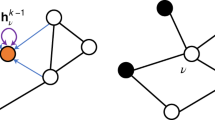Abstract
A maximum neuron model is proposed in order to force the state of the system to converge to the solution in neural dynamics. The state of the system is always forced in a solution domain. The artificial maximum neural network is used for the module orientation problem and the bipartite subgraph problem. The usefulness of the maximum neural network is empirically demonstrated by simulating randomly generated massive nstances (examples) in both problems. In randomly generated more than one thousand instances our system always converges to the solution within one hundred iteration steps regardless of the problem size. Our simulation results show the effectiveness of our algorithms and support our claim that one class of NP-complete problems may be solvable in a polynomial time.
Similar content being viewed by others
References
Cook SA (1971) Proc. of 3rd Ann. ACM Symp. on Theory of Computing. ACM, New York, pp 151–158
Garey MR, Johnson DS (1979) Computers and intractability: a guide to the theory of NP-completeness. Freeman, San Francisco
Geman S, Geman D (1984) Stochastic relaxation, Gibbs distributions, and the Bayesian restoration of images. IEEE Trans Patt Anan Mach. Int PAMI6:721
Hanan M, Wolff Sr PK, Agule BJ (1976). J Design Automat Fault Tolerant Comput 1:28–61
Hopfleld JJ, Tank DW (1985) Neural computation of decisions in optimization problems. Biol Cybern 52:141–152
Kirkpatrick S, Gelatt Jr CD, Vecchi MP (1983) Optimization by simulated annealing. Science 220:4598:671–680
Lee KC (1991) Ph.D. thesis. Case Western Reserve University, Cleveland
Lee KC, Takefuji Y (1991) CAISR Tech. Rep. TR91–104 (Center for Automation and Intelligent Systems Research, Case Western Reserve University, Cleveland)
Libeskind-Hadas R, Liu CL (1989) Proc. 26th Design Automation Conference. ACM, New York, pp 400–405
McCulloch WS, Pitts WH (1943) A logical calculus of the ideas mminent in nervous activity. Bull Math biophys 5:115
Preas BT, Karger PG (1988) Physical design automation of VLSI systems. In: Preas B, Lorenzetti M (eds) chap 4. Benjamin-Cummings, Menlo Park, Calif, pp 87–155
Takefuji Y, Lee KC (1990) A parallel algorithm for tiling problems. IEEE Trans Neural Networks 1:143–145
Author information
Authors and Affiliations
Rights and permissions
About this article
Cite this article
Takefuji, Y., Lee, KC. & Also, H. An artificial maximum neural network: a winner-take-all neuron model forcing the state of the system in a solution domain. Biol. Cybern. 67, 243–251 (1992). https://doi.org/10.1007/BF00204397
Received:
Accepted:
Issue Date:
DOI: https://doi.org/10.1007/BF00204397




